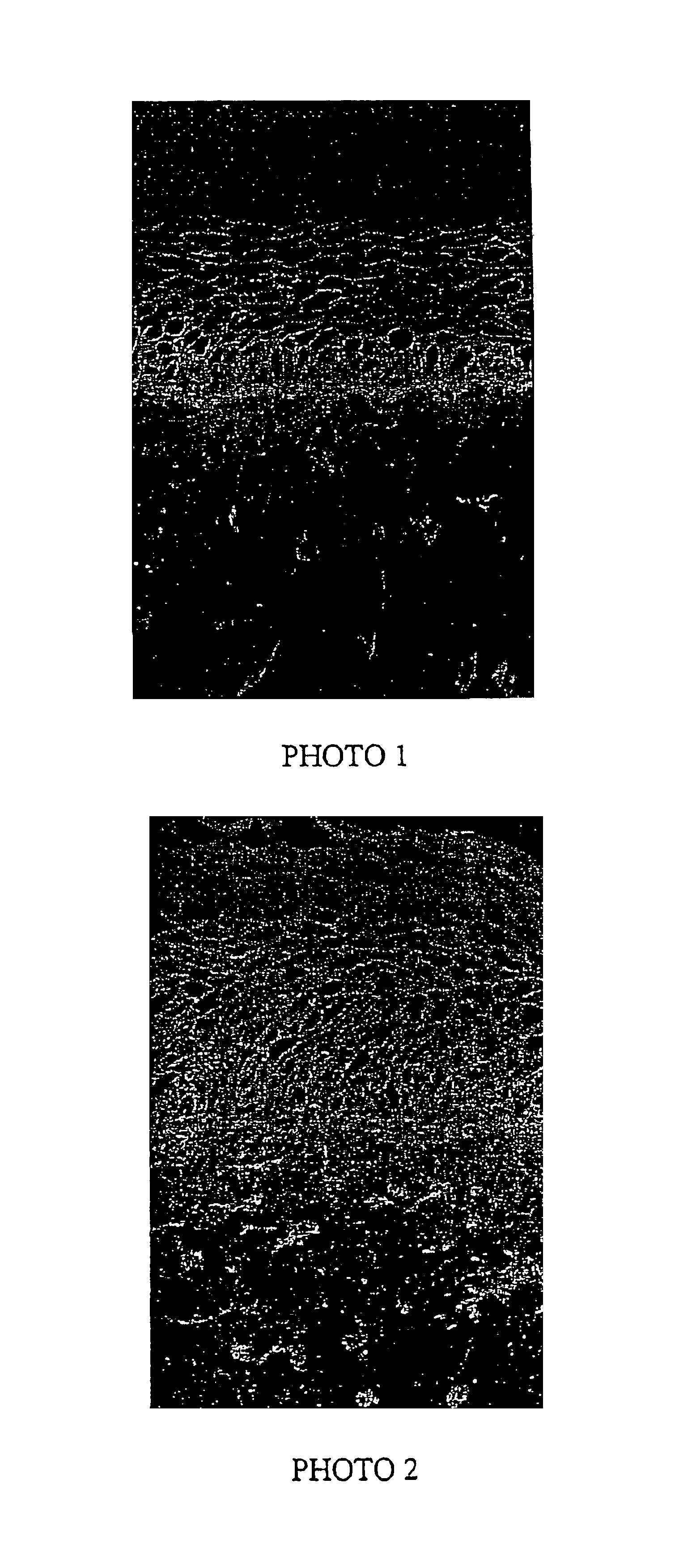Epidermis/dermis equivalents and aged skin equivalents shaped therefrom
a skin equivalent and epidermis technology, applied in the field of new skin equivalents, can solve the problems of unable to present the properties of an aged skin in vitro, and the inability of reconstructed skin in vitro to present the properties of an aged skin or permit study
- Summary
- Abstract
- Description
- Claims
- Application Information
AI Technical Summary
Problems solved by technology
Method used
Image
Examples
example 1
[0093]Preparation of Glycated Bovine Collagen I:
[0094]10 ml of bovine collagen I solution at a concentration of 3 mg / ml, 0.8 ml of 0.5N sodium hydroxide to neutralize the acidic collagen solution and 100 μl of a 1M solution of D-ribose in water were placed into a 50 ml Falcon tube.
[0095]The tube, rendered opaque to the light, was placed horizontally and gently shaken at room temperature (25° C.) for 1 month.
[0096]At the end of the “preglycation”, the solution was placed in dialysis tubing (Spectra / Poly labo 32 mm No. 132655 / 85716) and was subjected to a series of successive dialyses:
[0097]24 hours against demineralized water at 4° C. to eliminate the unbound sugar or the collagen degradation products;
[0098]7 days against 0.5N acetic acid to redissolve the collagen, in 2 baths of three and a half days;
[0099]3×24 h against 0.017N acetic acid with bath changing every day.
[0100]After the last dialysis, the contents of the dialysis tubing were recovered in a sterile beaker and the soluti...
example 2
[0102]Preparation of an Aged Dermis Equivalent:
[0103]3.22 ml of 1.76×MEM medium, 0.63 ml of foetal calf serum, 0.35 ml of 0.1N sodium hydroxide and 0.20 ml of an MEM medium / Hepes mixture containing 10% foetal calf serum (MEM / Hepes / FCS10) were placed into a sterile Falcon tube.
[0104]0.50 ml of MEM medium / Hepes / FCS10 were then added containing fibroblasts derived from human mammary plastic surgery which were prepared beforehand according to the technique described by Bell et al., 1979, (P.N.A.S. USA, 76, 1274-1278), Asselineau and Prunieras, 1984, (British J. of Derm., 111, 219-222) or Asselineau et al., 1987, (Models in Dermato., vol. III, Ed. Lowe & Maibach, 1-7), at a concentration of 1×106 cells for 0.5 ml of culture medium.
[0105]2 ml of a volume / volume mixture of preglycated collagen from Example 1 and non-glycated collagen having served in the preparation of the preglycated collagen from Example 1, at a concentration of 3 mg / ml in acetic acid at {fraction (1 / 1000)}, was then slo...
example 3
[0106]Measurement of the Level of Glycation of the Aged Dermis Equivalent From Example 2:
[0107]In parallel to the production of the aged dermis equivalent of Example 2, a dermis equivalent without glycated collagen (but with non-glycated collagen) was produced. This equivalent was used as a control in the determination of the level of glycation of the glycated dermis equivalent from Example 2.
[0108]Two lattices (one aged, one control) prepared according to Example 2 were rinsed three times in phosphate buffered saline (PBS), then dried. The lattices were then placed in an Eppendorf tube and subjected to digestion with pepsin (Sigma P-6887) at 37° C. in a water bath overnight (12 hours) in a proportion of 500 μg of pepsin per lattice in 0.5 ml of 0.5N acetic acid.
[0109]515 μl of 0.5N sodium hydroxide were then added to each tube and the contents of each tube were filtered through a 0.22 μm spin filter (Sigma).
[0110]The fluorescence was then measured with the aid of a Hitachi spectrof...
PUM
| Property | Measurement | Unit |
|---|---|---|
| Level | aaaaa | aaaaa |
| Distribution | aaaaa | aaaaa |
Abstract
Description
Claims
Application Information
 Login to View More
Login to View More - R&D
- Intellectual Property
- Life Sciences
- Materials
- Tech Scout
- Unparalleled Data Quality
- Higher Quality Content
- 60% Fewer Hallucinations
Browse by: Latest US Patents, China's latest patents, Technical Efficacy Thesaurus, Application Domain, Technology Topic, Popular Technical Reports.
© 2025 PatSnap. All rights reserved.Legal|Privacy policy|Modern Slavery Act Transparency Statement|Sitemap|About US| Contact US: help@patsnap.com

